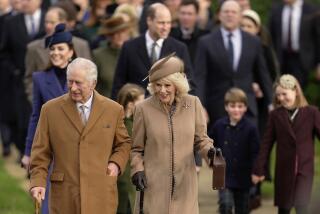Jordanian Ruler’s Form of Cancer Is on Rise in U.S.
- Share via
WASHINGTON — The cancer that left King Hussein of Jordan clinically dead Friday is on the rise but is usually considered one of the more curable forms of the disease.
However, in older patients, such as the 63-year-old king, treatment of non-Hodgkin’s lymphoma is trickier. The bone marrow transplant he underwent earlier this week is usually a last-ditch effort to cure the disease.
In this case it failed. Hussein left the Mayo Clinic in Rochester, Minn., on Thursday in critical condition and was declared clinically dead just hours after he arrived home in Amman, although he remains on life support.
Non-Hodgkin’s lymphoma arises in the lymphatic system, which includes a series of lymph nodes. Lymph nodes make some of the body’s immune cells, which are carried around the body by lymph fluid.
The American Cancer Society estimates that in 1999 more than 56,000 Americans will be diagnosed with non-Hodgkin’s lymphoma, and 23,000 will die of it.
There has been a steady increase in the number of cases, and it is now the fifth most common cause of cancer in men in the U.S., after prostate, lung, colon and bladder.
One reason for the increase is the AIDS epidemic. People whose immune systems are suppressed by the HIV virus are more susceptible to non-Hodgkin’s lymphoma.
The first symptom of the disease is enlarged lymph nodes, usually painless. But as it spreads to lymph nodes near organs, the nodes can enlarge and press against the organs, causing breathlessness, constipation, loss of appetite and pain.
Eventually, in nearly all patients who are not cured by other treatments, the bone marrow is destroyed. The body loses its source of new blood cells and cannot fight off infection.
Radiation treatment can extend a patient’s life and, when combined with chemotherapy, can cure about half the cases.
Yet for people over 60, such as Hussein, a cure is less likely. And it can take on a highly aggressive form that spreads quickly.
A bone marrow transplant, such as the one Hussein underwent this week, is a harsh procedure, one that allows no going back.
First, the bone marrow--where blood and immune cells are produced--has to be destroyed, usually by radiation or chemotherapy.
Then bone marrow from a donor is injected into the bloodstream, where it will find its way to the right place and hopefully start to grow and replace blood cells. Sometimes, the patient’s own bone marrow is first purged to remove any lymphoma cells, frozen and injected.
If it works, a patient is cured. But if it fails, the patient has no resources left and always dies.
More to Read
Sign up for Essential California
The most important California stories and recommendations in your inbox every morning.
You may occasionally receive promotional content from the Los Angeles Times.













